While many guitar makers argue over who invented the electric guitar first, there’s no doubt as to which was the first to be mass produced – and that guitar was the Fender Broadcaster, which was later renamed to the Fender Telecaster after some trademark disputes with Gretsch.
To this day, Telecasters remain incredibly popular due to their excellent comfort and legendary tones. To help you pick the best one for you, we’ve put together this KillerGuitarRigs Review of the 7 best Fender Telecasters. To make sure we were able to recommend something for all budgets, we’ve included everything from entry level Squiers to high end US made models.
Every guitar was tested through a Boss Katana head and Katana 2×12 cabinet for consistency. In the reviews we were primarily looking for feel and comfort, tone, and overall build quality.
If you’ve been thinking about getting a Telecaster, but you weren’t sure, then you’re absolutely going to want to keep reading.
Read more about our review process.
Our Top 3
The Fender Player Telecaster was our top pick in this roundup. It’s the most affordable Fender branded Telecaster in the lineup, and it really holds its own against much more expensive models in terms of looks, quality, and tones.
Those looking to avoid excessive spending should consider our best budget option, the Squier Bullet Telecaster. This may be the cheapest Telecaster made by Squier, but it delivers big on Telecaster tone and style, making it a real dark horse.
If you’re not concerned about cost, take a look at what we consider to be the best of the best – our Editor’s Choice, the Fender American Original ‘70s Telecaster Custom. This is a high end, pro spec instrument designed for the most demanding players.
Individual Reviews
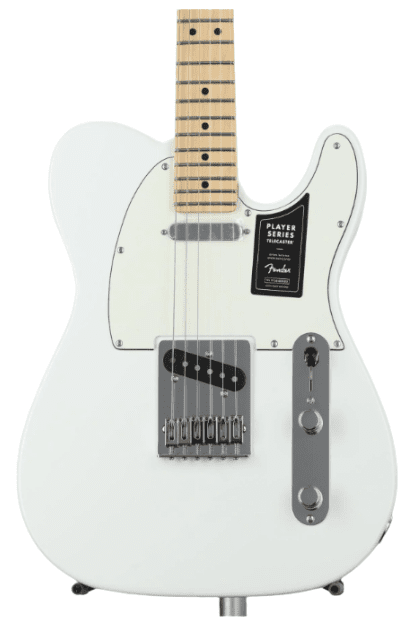
Fender Player Telecaster
A hard working, hard rocking Telecaster for players of all abilities.
If you need a rock solid Telecaster at an attainable price, and you’re dead set on a Fender, this is the one for you. It’s a Mexican made model built with the classic Telecaster recipe, and it offers truly impressive performance for players at all levels.
The Fender Player Telecaster sits at the bottom of the lineup when it comes to actual Fender models, but it’s still the type of guitar that many aspire to own and play. Our test model was a lovely 3 color sunburst example that had an exceptionally attractive grain pattern.
Player Series Telecasters all have maple necks, but you do have the option of either a maple, roasted maple, or a pau ferro fretboard depending on which color option you go with. The model we received for the test had a maple board with 22 nicely finished frets.
The neck profile was Fender’s Modern C Shape, which has become one of our absolute favorites. It’s slim enough to be fast and easily playable, but has enough heft to keep it from becoming fatiguing after extended use.
The body was made from alder, which is commonly used across the Fender range. It was light weight, and provided the snappy response you need for those twangy Telecaster tones. It had a string through bridge, which really added to the resonance and sustain. The saddles were the bent steel type rather than the barrel style – this might not be in accordance with Tele tradition, but having 6 individually adjustable saddles really does make intonation so much easier.
It had good quality hardware, and we were really happy with the sealed gear tuners. They turned smoothly and we didn’t find any slippage or tuning stability issues at all.
The pickups were both Fender designed and built Alnico V single coils. They had tone of presence and character, and really delivered when it came to classic Telecaster tones. We got brilliant spank and twang in the bridge position, and up in the neck we got great warmth with a tight mid range and excellent clarity.
Verdict: The Fender Player Telecaster is a great choice if you’re looking for the type of guitar you’ll never actually need to replace. It’s built like a tank, and would make the ideal workhorse guitar for the gigging musician who isn’t trying to break the bank on a new Telecaster.
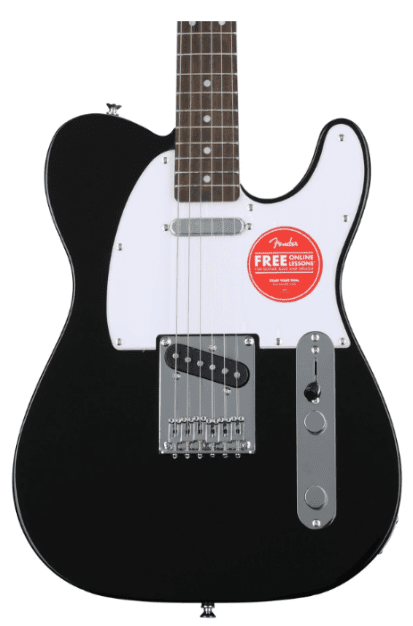
Squier Bullet Telecaster
Real Telecaster looks and tones at an incredibly affordable price.
If you’re on a tight budget and you need a cheap way to get Telecaster twang this is the guitar for you. It’s the lightest of all the Telecaster models thanks to its reduced thickness body, but it doesn’t lose out on any of the tone or style.
The Squier Bullet Telecaster was, despite being the least expensive by some margin, one of the most fun to play guitars in the whole roundup. Fender’s Squier brand has clearly put a lot into improving the Bullet Series, which just a couple of short years ago was really disappointing to put it frankly.
Our test model had a maple neck with a C shape profile. It was a little thicker than you’d expect for what is effectively a guitar aimed at beginners, but it had good ergonomics, and would still suit younger players and those with smaller hands.
The fretboard was made with Indian laurel, which isn’t our favorite wood at KGR, but in this case it was absolutely fine. The pores weren’t bad at all, and the wood was nicely hydrated when we received it. It felt good under the fingers, and gave us no cause for complaint. It had 21 narrow tall frets, which are ideal for newer players getting used to learning guitar.
It had a poplar body, which is usually more common on Strats than Telecasters, but it didn’t affect performance in any significant way. In fact, it resulted in reduced weight, which further added to the comfort of this guitar. This updated version of the Bullet Telecaster didn’t have the traditional string through body as the old version did, but this does make string changes a little easier for less experienced players.
We found that the tones were brighter than the average Telecaster, and that was most likely down to the ceramic single coil pickups, which run hotter than their Alnico counterparts. The twang from the bridge pickup was particularly potent owing to the high output, and the neck position gave us some really nice country tones.
Verdict: The Squier Bullet Telecaster has come a long way in recent years, and now it’s so much more than just a cheap Tele. It’s lightweight and comfortable to play, and at a glance, it’s almost indistinguishable from more expensive models. It sounds great, and while it might not be a gig-ready guitar, it’s definitely more than suitable for learning the basics.
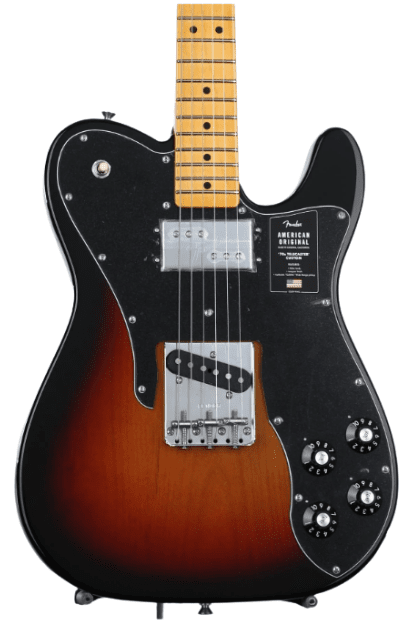
Fender American Original ‘70s Telecaster Custom
Stunning good looks, second to none playability, and fantastically diverse tones.
This Telecaster is truly a product of its time, both in terms of looks and tone. It’s a high end, meticulously built model, that’s proudly built in the USA. It uses premium materials and electric components, and is ready to take on any stage or studio right out of the box.
The neck of the Fender American Original ‘70s Telecaster Custom had a ‘70s era C profile, which we found to be slim, and offered us superb playability. It was made from maple, and was finished with a stunning rosewood fretboard. The fretboard was smooth, and felt amazing under the fingers. We loved the fretwork, too. There were 21 Vintage Tall frets, which in conjunction with the 9.5” fretboard made this guitar a dream for lead work.
The test model we got to play was finished in 3 color sunburst, which is arguably the best color for these Custom models. It had a solid alder body with a beautiful grain pattern. Unlike most of the Mexican made models, it didn’t have a veneer, so we found ourselves really impressed with the quality of the fit and finish. It had a nitrocellulose lacquer, which was period correct and felt great. Of course, being nitro finished, it will also check and age naturally with time and use.
It had a traditional Telecaster bridge with the 3 barrel style saddles and a string through body. While these saddles might not be as easy to set up as a 6 saddle bridge, we still found that the intonation was perfect out of the box.
We loved the Fender F Stamped vintage style tuners. Their performance was head and shoulders above the rest of the field, and the look suited the guitar perfectly.
One of the most interesting aspects of the design of this ‘70s Custom was that it came with a Tim Shaw wide range humbucker in the neck as opposed to the single coil you’d find on a traditional Tele. It did still give us the Telecaster tones we wanted though, thanks to the traditional single coil in the bridge position.
Having the humbucker in the neck gave it great clarity with great thickness and no hum when playing clean, and the Vintage Style ‘70s single coil in the bridge was incredibly responsive, and full of glorious. When it came time to add some overdrive, both pickups got good and rowdy without ever getting muddy.
Verdict: The Fender American Original ‘70s Telecaster Custom offers much more than the traditional style Tele, and the best part is that it still feels like a Telecaster. The body dimensions are the same, and in fact, the humbucking neck pickup and the treble bout mounted selector switch are serious upgrades from the standard layout. It’s a riot to play, and offers a lot more tonal variety than you’d expect.
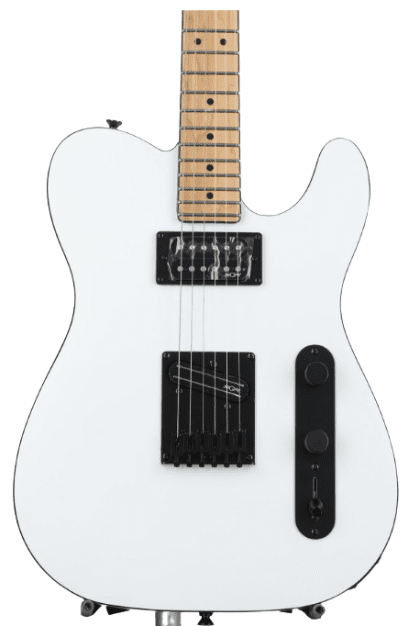
Squier Contemporary Telecaster
Screaming tones and modern looks make this Tele stand out from the crowd.
Telecasters are mostly known for their clean tones, but then there are versions like this that were designed for heavier styles, while retaining the timeless aesthetic. This Tele has some of the best playability you’ll find from guitars on this platform, and even comes with upgraded humbucking pickups.
The Squier Contemporary Telecaster came with a 1 piece roasted maple neck, which is one of our favorite looks. As with many other Squiers, it had a C profile which we found to be both extremely comfortable, and forgiving for newer players, while at the same time promoting fast playing for more experienced guitarists. The fretboard was also roasted maple; it felt great, and again, looked brilliant in contrast with the Pearl White finish.
The fret edges were well finished with no sprout or sharps, but we were a little disappointed with the finish on the fret crowns – they were level, but a little rough. This is an easy fix with a fret dress, but it would have been nice to see smoother frets out of the box.
In keeping with other Squier Telecasters, it had a poplar body, but unlike the Bullet (and Affinity) Series, the body was full thickness. The use of poplar has shaved about 1lb off in comparison with models made with alder, so fans of light weight guitars will love the Contemporary Tele. Like the fretboard, the body also had black binding, which looked good, and will likely help to preserve the edges from bumps and knocks.
We loved the unique look of the black hardware. It had the standard sealed die cast tuners which held tune well once set, but getting there took some time due to the play in the gearing.
If you’re looking for traditional Telecaster tones, this isn’t the guitar for you. It had an SQR Atomic humbucker in the neck, and an SQR rail humbucker in the bridge. It delivered big chunky tones, with exceptional cleans and searing overdriven performance. In fact, the pickups far exceeded what we thought we’d ever manage to get out of a Squier.
Verdict: The Squier Contemporary Telecaster is definitely geared towards metal and hard rock players rather than the traditional Tele audience, and it’s great that Squier has created a model to suit this need. It’s well made, and despite some minor (and easily remedied) flaws, it’s still a fantastic guitar at a great price.
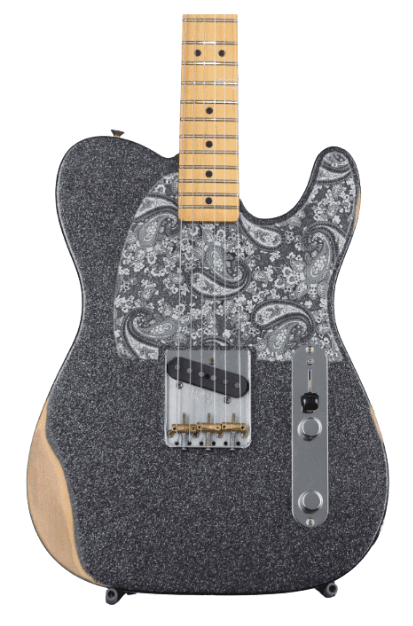
Fender Brad Paisley Road Worn Esquire
Esquire looks with Telecaster versatility – a real secret weapon.
With this guitar you can have it all – the sleek looks of the original Esquire, with the additional tones and performance that come with having the Telecaster’s second pickup in the neck position. It has a premium nitro finish, and fantastic road worn looks that just scream country.
The Fender Brad Paisley Road Worn Esquire delivered fantastic broken in comfort with its Enhanced V shape maple neck. It was an extremely ergonomic feel, and we think it will suit players with medium to large hands best. It had a maple fretboard, with 21 well finished medium jumbo frets.
Being a road worn model, it came with a light factory relic job. Pre-relic’d guitars can be polarizing, but the wear on this model is relatively subtle, and really looked good. The body is made with spruce and paulownia, making it one of the lightest Teles on the market.
Hardware was gently aged, with mild pitting rather than the all out rust you might find on a heavy relic model. It had classic appointments like a top hat selector cover, 3 brass barrel style saddles, and vintage style tuning keys, which did a phenomenal job with fine tuning.
This model is sold as an Esquire, which was a single pickup guitar that predated the Telecaster, but just as on Paisley’s own guitars, it features a hidden single coil underneath the stunning Paisley pattern pickguard, unlocking the full spectrum of telecaster tones, with the classic look of the Esquire.
The pickups are custom wound to Brad Paisley’s specs which gave us fantastic vintage country cleans, with the Hawaiian steel style twang that makes these guitars so famous. This model does so much more than country, though. The hidden neck pickup had a low to medium output, it was soft and understated, making it perfect for jazz and even blues. The bridge was far hotter, and came close to P90 snarl when pushed hard.
Verdict: The Fender Brad Paisley Road Worn Esquire is not only unique looking, but it has a broad range of tones that work brilliantly for everything from jazz to country and rock. A lot of care and attention has gone into the build of this guitar, which is sure to appeal to advanced amateurs and professional musicians alike.
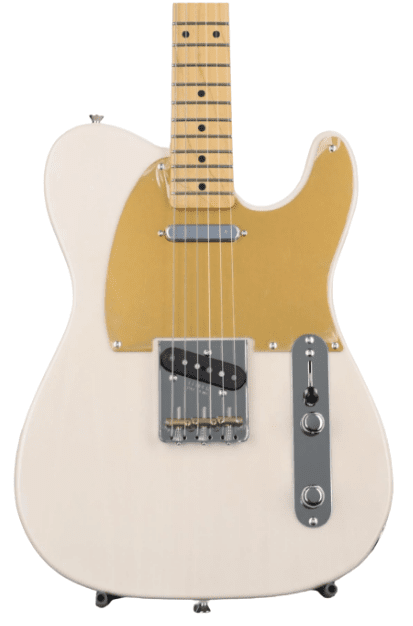
Fender JV Modified ‘50s Telecaster
Classic ‘50s Telecaster styling with modern playability and peerless build quality.
In the 1980s Fender outsourced production of their ‘50s reissues to Japan, not expecting them to become some of the most popular models in the brand’s history. Today’s Japanese made Telecasters offer the same meticulous attention to detail and ‘50s aesthetics, with serious quality and playability upgrades.
Early Telecasters were notorious for their beefy necks, and while the Fender JV Modified ‘50s Telecaster has a Thick Soft V profile, its superior ergonomics make it much more comfortable for a wider range of players than the early baseball bat style necks. It had a maple neck and fretboard, with a period correct vintage tint. The fretwork was on par with the American Original ‘70s model, with perfect edges and beautifully polished crowns.
It had a basswood body, which is a lightweight wood that’s a bit softer than alder and ash, making it more reminiscent of the pine used in early models. It had the classic string through body, which gave it tons of sustain and resonance, and this was also helped by the brass barrel style saddles which transferred every last vibration through the body. Of course, the biggest drawback is that the intonation can be incredibly difficult to adjust if you modify your action with these barrel saddles, so that’s something to be aware of.
We especially loved the pickups on this JV modified Tele. As well as getting the classic Telecaster tones, it had push pull pots that gave us a range of tonal versatility that isn’t typically possible in standard Telecasters. The push pull activates an out of phase tone, that gave it a thinner, more quack like tone, similar to the 2 and 4 positions in a Stratocaster.
Verdict: The Fender JV Modified ‘50s Telecaster brings incredible build quality to the table alongside excellent playability and great tones. If you aren’t too worried by the difficulties that can come with barrel style saddles (or you’re willing to swap them for individual saddles), then you’ll have a Tele with the best of all worlds – classic looks, sonic variety, and excellent comfort.
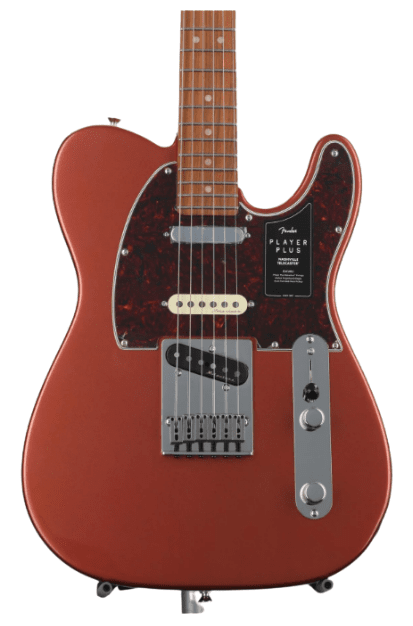
Fender Player Plus Nashville Telecaster
Stratocaster versatility with Telecaster tones and looks.
This is the ideal guitar for players who demand the clan, spanky Telecaster sound, but who also want the tonal range that comes with having a third pickup in the middle position. In addition to the extra pickup, this model also benefits from improved ergonomics, which is a welcome feature for experienced Tele owners.
The Fender Player Plus Nashville Telecaster is an evolution of the classic design. It’s fitted with the same excellent Modern C neck as the regular Player Series model, and is also available with a choice of maple or pau ferro fretboards. The neck was as comfortable as we anticipated it would be, and it had the same high quality fretwork.
Our test model had the pau ferro fretboard, and unfortunately it was quite dry, giving it a very washed out look and a little bit of a rough feel. Fixing this is pretty straight forward with some oil or fretboard conditioner, but it’s definitely something we wish was taken care of at the factory.
It had an alder body finished in Aged Candy Apple Red. The nicest feature of the body was the fact that it actually had a belly carve. Telecasters are typically slab body guitars, so to have a comfort contour made a massive difference, and despite the fact that it’s not historically accurate, we do wish Fender would put this on all Telecaster models.
As for hardware, it was outfitted with a 6 saddle bridge, with modern style stainless steel saddles in use. These are a huge step up from the bent steel vintage style, and gulfs beyond the original barrel style saddles. This was the only model in the roundup fitted with locking tuners, and they made a vast difference in performance, with incredible tuning stability and rapid string changes.
What makes this a Nashville Telecaster is the addition of the middle pickup, but remember, this doesn’t make it a Strat with a different body. It still has the low output Tele neck pickup, and the steel plate on the bridge is paramount in instigating the twang. The bridge and middle pickups were Fender noiseless single coils, which gave us great, quiet performance.
The range of tones from this guitar was really excellent, overall. In the bridge position we got bright, spanky cleans, and gritty overdriven tones. The middle pickup unlocked some of the great out of phase tones that Strat players love, and in the neck position it was rich and dark, but never muddy.
Verdict: The Fender Player Plus Nashville Telecaster is a great option for players who like to experiment with a broad range of tones and who perhaps play in multiple genres. It offers improved ergonomics over standard models, making it one of the most comfortable Telecasters on the market, too.
How To Choose The Right Tele For You
The Telecaster has been an icon since day one, launching dozens, if not hundreds of variations and swathes of copies over the years. If you’re considering taking the plunge and buying a real original, you’ll need to know what it is you’re looking for if you want to find the perfect Tele for you.
Price Point
It may seem obvious, but you’ll need consider your budget before making a decision on which model you want to buy. Telecaster shoppers on the tightest budgets (think sub $500) will be limited to Squier models. Don’t be deterred by this however, as there as some truly fantastic Squier Teles that come incredibly close to base model Fenders at a fraction of the price.
In the mid range prices ($850 – $1600) you’ll have the option of Mexican made or Japanese made models – although this isn’t necessarily a hard and fast rule, as some of the higher end Mexican made Teles cost more than base model American models.
In the upper tier you’ll find the American made models, which retail for around $1400 and upwards into stratospheric numbers. These are made at the flagship Corona, CA factory, and represent the finest guitars in the Fender lineup.
Pickup Options
Depending on what you plan to use your Telecaster for, consider the pickup arrangement you’re going for. For example, if you’re planning to play strictly country, then a Squier Contemporary Telecaster is not the best option for you. Similarly, if you’re a metal player, a Brad Paisley Signature model won’t help you get the tones you’re looking for. Luckily there are a range of replacement Tele pickups on the market for all styles.
Telecasters come with a range of pickup configurations, including:
- SS – Classic configuration, works well with country, pop, folk, and rock
- SSS – Nashville configuration, great for country, pop, blues, jazz, and rock.
- HS – Modern configuration that’s ideally suited to country, pop, blues, jazz, rock, and even hard rock
- HH – Contemporary configuration, which is best for those playing blues, rock, hard rock and heavier styles like metal.
Final Thoughts
After the launch of the Stratocaster, the Telecaster was, by design, the entry level model in the line up. It didn’t have the ergonomics, or the high tech trem system, but what it did have in bunches was character, and that’s what has helped it survive in continuous production to this day in a relatively unchanged state.
To recap our favorite models from this roundup, starting with our top pick, the Fender Player Telecaster, which delivers all the classic Tele tones at an attainable price. We chose the Squier Bullet Telecaster as our best budget option thanks to its reliability, great build quality, and excellent playability for beginners, all for under $200 at most retailers. For players looking for the best Telecaster around, our Editor’s Choice award went to the Fender American ‘70s Telecaster Custom, which impressed across the board, from build quality, to looks, and especially tones.


